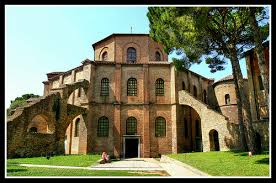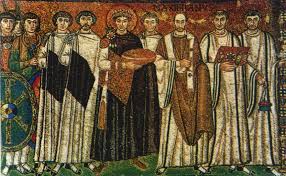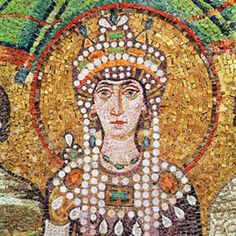Theodora not only shows up in texts throughout history, she also makes an appearance in several artistic mediums. There are two pieces of artwork that I will be referring to in particular for the purpose of this project. One is a mosaic that was created in Theodora’s lifetime and the other is a painting created hundreds of years after her death. The mosaic presents the most realistic illustration of what Empress Theodora looked like. It is located in the Church of San Vitale in Ravenna, Italy. The church itself is domed/octagonal shaped with an interior ambulatory covered in mosaics. I learned all of this by viewing an awesome Khan Academy video which is linked below.


The mosaics that feature Theodora and Justinian were probably installed as propaganda pieces to show their reassertion of power in Italy and orthodox Christianity. The mosaics face one another and are explained more extensively in Marilyn Stokstad’s reference book, Art History Volume One. She writes, “Justinian on the north wall, carries a large gold paten…on the south wall, Theodora, standing beneath a fluted shell canopy and singled out by a gold halolike disk and elaborate crown carries a huge golden chalice” (260). When examining the mosaics, one can see that each monarch is flanked by important men and women of the Constantinople empire. Justinian and Theodora are both clad in royal purple robes and are bedecked in jewels. Theodora’s “huge jeweled and pearl-hung crown nearly dwarfs her delicate features, yet the empress dominates these worldly trappings by the intensity of her gaze” (Stokstad 261).



Paolo Cesaretti sums up the allure of this mosaic by focusing on the symbolism behind her artistic portrayal. He writes:
“Each year, hundreds of thousands of people flock to this northern Italian city solely to admire the portrait of Empress Theodora and the image of female power and pomp that she projects-still a rarity in world art. Her portrait exudes an authority that lingers like a seduction in the visitor’s memory, and yet many of her admirers are hard pressed to link her to an exact event, or even to situate her in the immense grid of space and time” (Cesaretti n.p.)
It is that elusiveness that Cesaretti hits on which makes Theodora so appealing to the masses. Her story is applicable in various myths throughout history; a woman of low birth sells herself and eventually becomes a figure of power all while remaining steadfast in her self. That is why and early feminist such as Christine de Pizan can draw from Theodora’s tale almost one thousand years after her death.
The other well-known piece of artwork depicting Empress Theodora is an oil paining by the French artist, Jean Joseph Benjamin Constant. It was commissioned sometime between 1845 to 1902 and depicts a romanticized Theodora wearing a bejeweled crown and looking pensively out a window. The painting recently sold at a Christie’s auction in 2007 for $90,000, proving that the fascination of Theodora is still alive and well.

Link to painting auction for more info: http://www.christies.com/lotfinder/paintings/jean-joseph-benjamin-constant-the-empress-theodora-5000270-details.aspx
Works cited for this page:
Cesaretti, Paolo. Theodora: Empress of Byzantium. New York: Vendome, 2004. Print.
Stokstad, Marilyn. Art History. Upper Saddle River, NJ: Pearson Prentice Hall, 2008. Print.